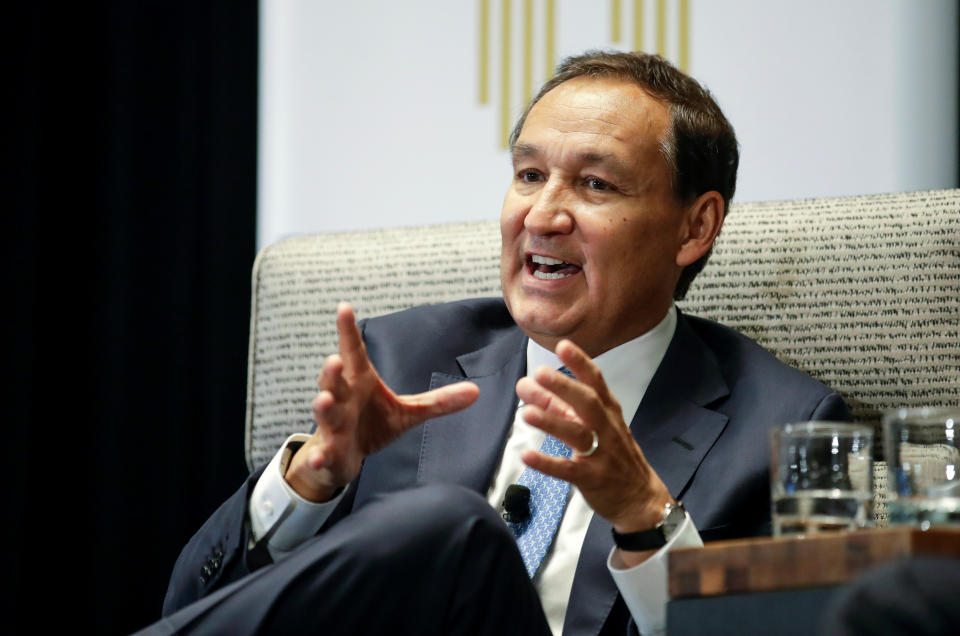United CEO Oscar Munoz wants to 'change how you feel flying with us'
A more confident and stronger United Airlines (UAL) held its first media day in Chicago on Friday to highlight multimillion dollar investments in aircraft, seating upgrades and employee training designed to improve the passenger experience.
“We’ve taken the narrative from what’s wrong to what is next. It’s about changing how you feel flying with us,” United CEO Oscar Munoz said.
He highlighted the transformation called the “New Spirit of United,” which started in 2016 with a listening tour talking to employees and customers. Munoz says the turning point came when a flight attendant told him,”I am just tired of always saying sorry.”
Munoz took responsibility for mistakes like the incident when a passenger was physically dragged off an overbooked flight in 2017. Last June, Munoz acknowledged that for passengers on most airlines, flying has become stressful saying, “By the time you sit on one of our aircraft, you’re just pissed at the world.”

The commitment to improving customer experience, Munoz says, can be measured in “proof not promise” — and it appears to be working. The airline’s last earnings report surpassed Wall Street’s expectations, posting adjusted net income of $1 billion. Over the last 52 weeks, United stock (UAL) is up almost 10% — outperforming competitors like Delta (DAL), American Airlines (AAL), and Southwest Airlines (LUV).
United Airlines President Scott Kirby told Yahoo Finance’s Adam Shapiro, “We’ve got all the building blocks in place. The next phase is to get customers to choose to fly United.”
One of the things United has done is upgrade its mobile app to help communicate better with passengers, “To tell customers in language they can understand what’s going on,” Kirby said. “If there is a flight delay, if there is weather explaining why, because if you take that uncertainty out, it really helps to calm people down,” Kirby added.
Keeping stock flying high
The airline has committed to growing capacity 4% to 6% year over year through 2020, but analysts like Jim Corridore at CFRA Research worry the added capacity will challenge United’s ability to control key metrics like cost per available seat mile (CASM) and (PRASM) passenger revenue per available seat mile. “How are you going to be able to continue to grow unit revenues while adding capacity and defending your market share?” Corridore asked.
United expects to grow the average number of seats per departure 10% to 15% by 2025, something Kirby says is a “huge tailwind” for CASM.
“If we add a 737 and let’s say we have 166 seats on it and we replace a 50 seater with 50 seats on it, everyone of those departures is 116 more seats and the cost per seat on a 737 is a lot less per seat than on a 50 seat airplane,” Kirby said.
Many of the costs are fixed Kirby points out, adding, “You get to spread those fixed costs out over more seats.”
But added capacity may hit all airlines next year if Boeing’s 737 Max is allowed to return to the skies. The extra seats could force airlines to cut prices to lure passengers to fill those empty seats. Corridore says United needs “to be careful at how quickly they grow capacity and continue to utilize their hub strength.”
Kirby says, “We’ve increasingly seen as we’ve invested in the customer experience, we’ve invested in the customer product that customers are choosing to fly United Airlines. So we are able to outperform even in a difficult macro environment because of the investments we are making the improved operation and customer experience that are causing people to choose to fly United Airlines,” he said.
Adam Shapiro is co-anchor of Yahoo Finance On the Move.
Read the latest financial and business news from Yahoo Finance
Follow Yahoo Finance on Twitter, Facebook, Instagram, Flipboard, LinkedIn, YouTube, and reddit.